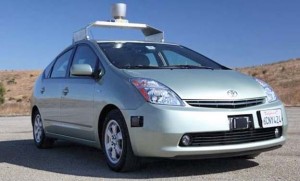Four prototype autonomous vehicles been involved in accidents on California roads over the last eight months, three of them while undergoing testing by Google, considered a leader in the development of self-driving technology.
In two of the crashes, the vehicles were operating in fully autonomous mode, according to a report by the Associated Press. In the other two, the vehicles were being operated in manual mode, meaning a human driver had taken control.
The AP reported that all of the crashes occurred at relatively low speeds – less than 10 mph. It was not reported whether there were any injuries or how serious the vehicles were damaged.
The autonomous vehicles were not at fault in any of the accidents, according to Google and Delphi, an automotive supplier that also has been developing autonomous technology. Both companies claimed the crashes were “minor,” according to the news service.
AP reporters noted that the California Department of Motor Vehicles does not release details of motor vehicle accidents, declaring that information confidential. Under new and evolving regulations, the state has so far issued permits for seven different manufacturers to test 48 vehicles in California on public roads.
California was the second state to put together a specific licensing procedure for autonomous vehicles, following Nevada. That state last week issued the first permit ever for testing an autonomous semi-truck, the Freightliner Inspiration.
(What’s it like to drive an autonomous, 70,000 pound truck? Click Here to find out.)
The number of autonomous vehicles on the road is expected to jump sharply in the near future. Google alone is pulling together a fleet of 100 bubble-shaped prototypes that will be used in tests near its Silicon Valley headquarters. Those vehicles are being produced by Michigan supplier Rousch.
The Google vehicles involved in three crashes were, however, modified Lexus SUVs. They have logged thousands of miles during the tech giant’s testing program. Google has become one of the biggest proponents of autonomous driving – but it also has said it has no plans to go into the automobile business and would hope to find an automaker to partner with.
Delphi is developing a variety of sensors and software systems that also would be used by automakers in their own autonomous vehicles.
(The future is electric, says GM — but maker is missing its battery-car sales goals. Click Here for more.)
Several manufacturers, notably including Nissan, have said they expect to put their first fully autonomous vehicles on the road by around 2020 – though semi-autonomous systems will be debuting on a number of vehicles, such as the Cadillac CT6 sedan, by 2016.
For now, California, Nevada and other states are requiring that a human driver be positioned behind the wheel ready to take control in the event of a problem. That is not expected to change for at least another decade, according to most experts.
Manufacturers are promising that autonomous technology will significantly improve the safety of U.S. roadways, so any crashes that occur could pose an embarrassing setback, even if the self-driving vehicles aren’t at fault.
Public acceptance is one key issue, but “lawmakers and regulators will be key” to getting the technology on the road, stressed Martin Daum, the president and CEO of Daimler Truck, during the preview of the Freightliner Inspiration truck last week. Safety concerns could set back a goal of getting nationwide approval to test, and eventually market, autonomous vehicles.
(New JD Power study finds autonomous vehicles resonating with American drivers. Click Here for details.)


This is precisely why I am not a supporter of rushed-to-market testing on public roadways. As I have stated several times before, there are huge hurdles for AVs to overcome for them to be safe for actual highway use. I would have thought that even in manual mode the anti-collision devices should have been operating? What’s with that?
ALL AV accidents should be reported and fully investigated by NHTSA – NOW before anyone gets approval for true AV operation on the roadways. We know that when large sums of money is at stake, accident reports for AVs could easily be falsified to eliminate any concern about safety.